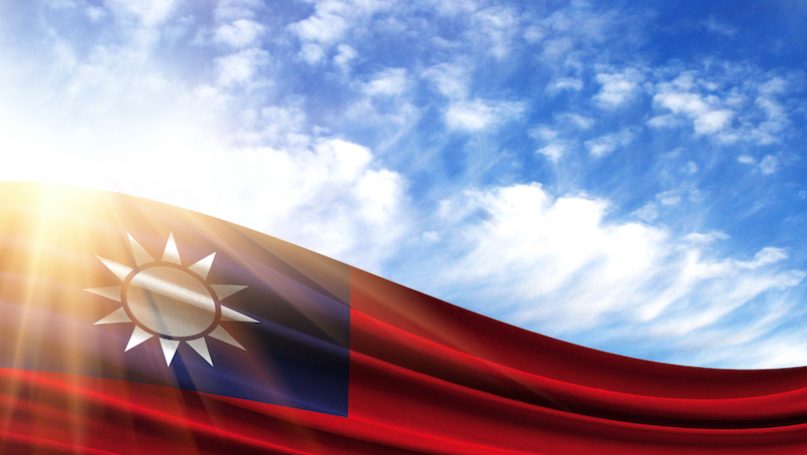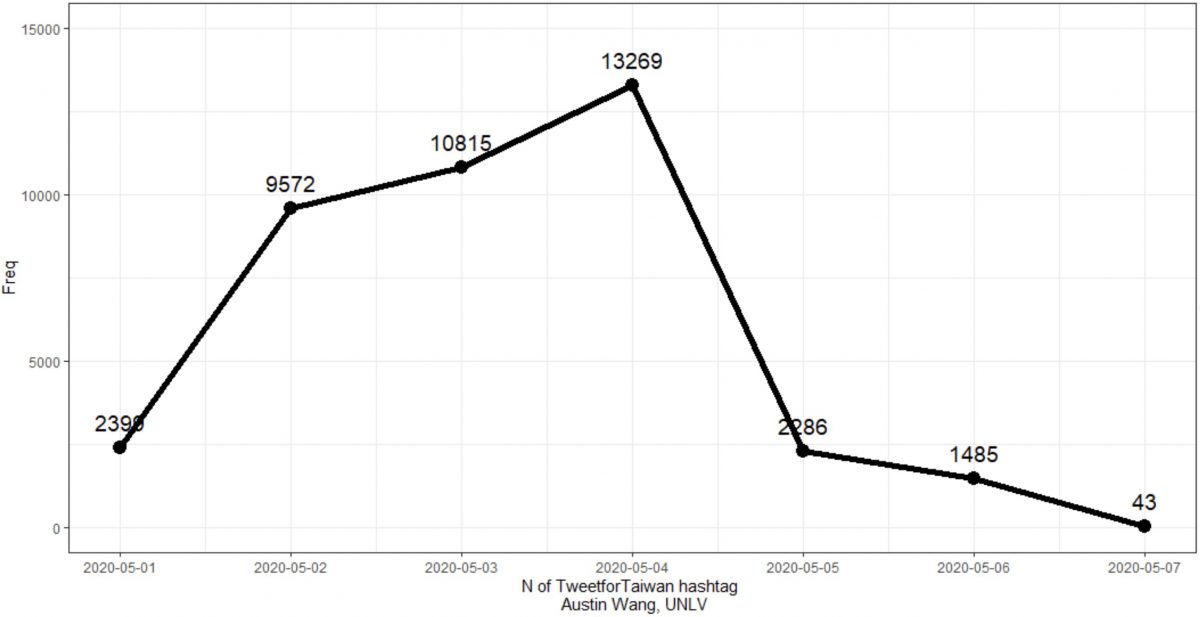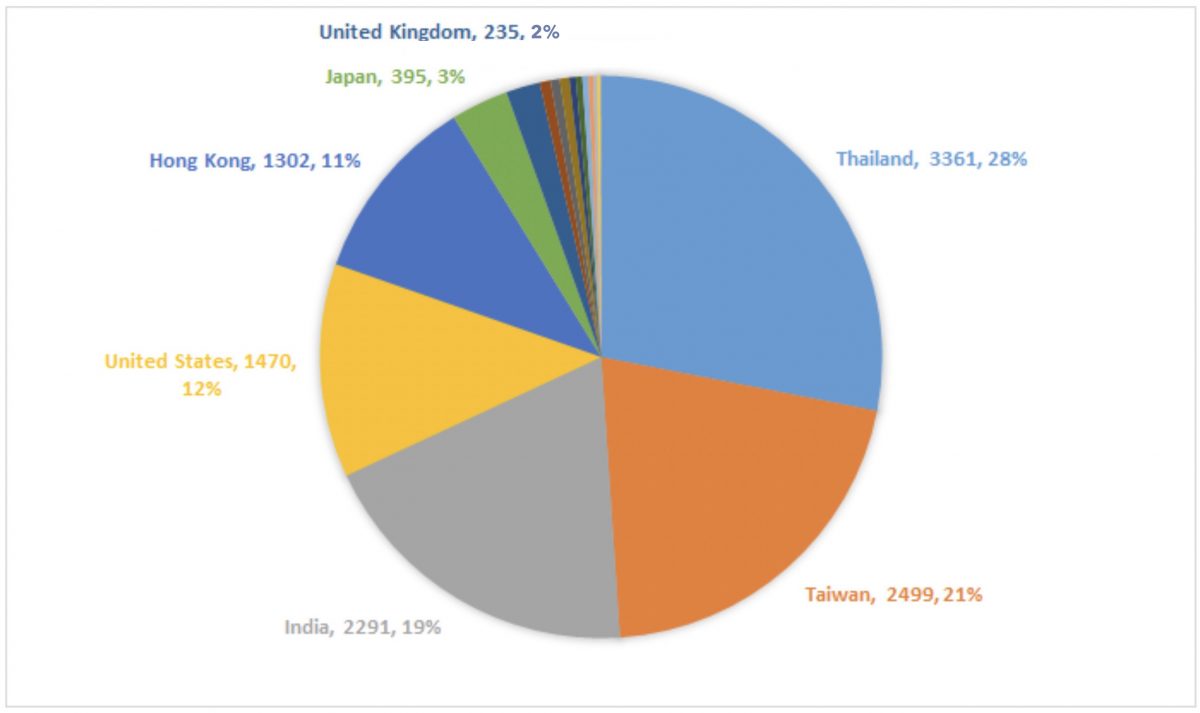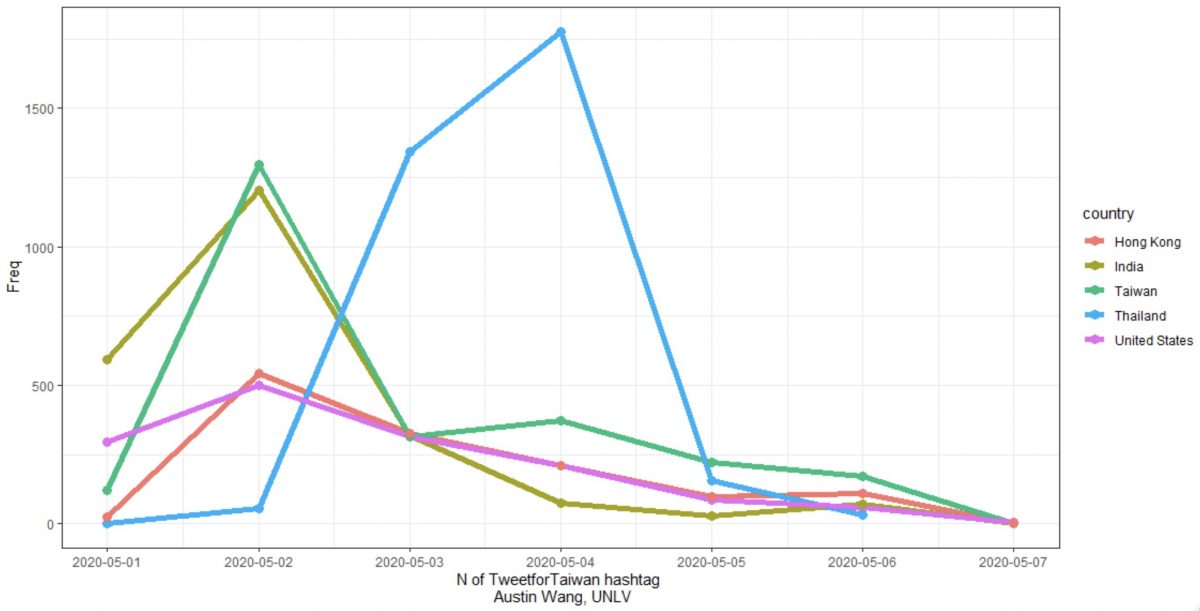
Recent tensions between China and India on their border have prompted India to adopt tougher policies against Chinese tech companies and consumer software. To balance China’s growing power in Asia, some Indian analysts are also calling for a closer relationship with Taiwan, who has been a victim of China’s oppression in international society. There is evidence to suggest that a tactical alliance, dubbed the #MilkteaAlliance, has formed among civil societies in many countries including Taiwan, Hong Kong, India, and Thailand. In early May, the US Department of State initiated the #TweetforTaiwan campaign to support Taiwan’s participation in the World Health Assembly (WHA). Within days, the campaign gained momentum as officials from the U.S. Mission to the UN and various congressional members voiced their support. Aside from the strong support of US policymakers there is evidence that the movement has also won support in other parts of the world.
Some analyzed around 500 tweets on the first day and surprisingly found that most of them came from India, accounting for nearly half of the first-day tweets. We extended the scope of this analysis to at least one week, investigating where most of the tweets came from, and the rationale behind these tweets. We scraped the hashtags #TweetforTaiwan from Twitter using scrapping software, TAGS from May 1 to May 7 2020, resulting in around 40,000 tweets. As shown in Figure 1 below, there were already over 2,000 tweets on the first day, and the number quadrupled in a matter of 4 days.
Figure 1. #TweetforTaiwan on Twitter, May 1–7, 2020

The nearly 40,000 tweets, however, are not readily available for analysis, as not every tweet included a location, and even if it did, it is often self-reported. This could be a source of bias. Specifically, close to 18,000 users chose not to disclose their locations, whereas the remaining portion includes unintelligible locations. Those that have included cities in their tweets also did not help much without naming a specific country. Cleaning up the data resulted in 11,974 available tweets. Let us take a look at the distribution of countries for them in Figure 2 below.
Figure 2. Distribution of #TweetforTaiwan by countries

During May 1–7, most tweets took place in Thailand, followed by Taiwan, India, the United States, and Hong Kong, all of the aforementioned countries together accounting for more than 90% of the tweets. This result is emblematic of the recent burgeoning Milk Tea Alliance linking Taiwan, Thailand, and Hong Kong. On the surface, our analysis seems to contradict the findings that India accounted for most of the tweets on the first day. It does not. According to Figure 3, a chronological time-line of these tweets, we agree with the previous finding that India and the United States made up of most tweets on the first day. Starting on the second day, tweets from Taiwan exploded to take the first place, while tweets from the United States, India, and Hong Kong continued to rise. Taking up the torch the next day, netizens in Thailand contributed the most tweets in the next two days.
Figure 3. Timeline of #TweetforTaiwan

To quell these doubts, we applied several approaches to re-analyze these tweets. First, we examine the medium of the followers of each user (a recent study shows that fake accounts often have few followers and have few activities with their accounts). The median of the number of followers for all the accounts used in the analysis was 110, and 292 is the median number of people these accounts are following. Breaking down by country would still suggest that these accounts are authentic. The median for followers and following for users in India was 92/286, Thailand 140/343, United States 188/365, Hong Kong 248/397, and Taiwan 52/173.
There are a couple of reasons why citizens in India are helping Taiwan with the WHO bid. This history between India and China went back to 1962, when several violent border skirmishes escalated into a shooting war, killing thousands on both sides. Right in this Month, Chinese and Indian soldiers engaged in another border skirmish, causing minor injuries on both sides. Tensions have flared up again recently since COVID-19 spread out of China and became a pandemic earlier this year. The media in India have been lashing out at China for using the pandemic to improve its international image. The economic downfall as a result of the pandemic further creates rivalry – as quarantine forces factories to leave China, India opens its arms to them. Attempts at chipping away China’s economic prowess ire Beijing. The falling out between India and China motivates the public in India to support Taiwan in defiance of China.
Support from netizens in Thailand can be seen as a continuation of the recent nnevvy incident (see 1, 2, and 3). The incident originated when Thai citizens made comments online interpreted as a supportive move for the ongoing anti-China protests in Hong Kong, which triggered Chinese nationalist trolls in response. The nationalists found their attacks futile as Thai netizens seemed to relish and even appreciate those negative comments. Creative Thai netizens soon flooded Twitter with self-deprecating memes and gave birth to a Milk Tea Alliance when users from other milk-tea-loving countries stood in solidarity with Thais. Thus, the support from Thais for Taiwan can be understood as memories of the incident are still vivid.
As scholars of international politics debate the extent to which the Covid-19 pandemic could reshape world order, the twitter storms from these recent incidents could shed light on this discussion. What seems clear is that the virus has not brought seismic changes in the balance of power between hegemons such as the United States and China. Instead, potential changes to the international world order could very well come from the public, and ciivil society, across the globe. Advances in communication technologies have enabled citizens in different countries to bind over the issue of common interests in a short time. Going forward, it will be interesting to see if these alliances of netizens could continue to strengthen or even, replace traditional alliance patterns in international politics.
Further Reading on E-International Relations
- Celebrity, Social Media and Disputes Over Taiwan’s Sovereignty
- The Fourth Year of the Milk Tea Alliance
- Opinion – Omens for US-Taiwan Relations in the Biden Administration
- Opinion – Taiwan’s Almighty Squeeze
- Opinion – Beijing’s Weaponisation of Diplomacy Against Taiwan
- Is China Under-Exploiting One Legal Avenue in the South China Sea?